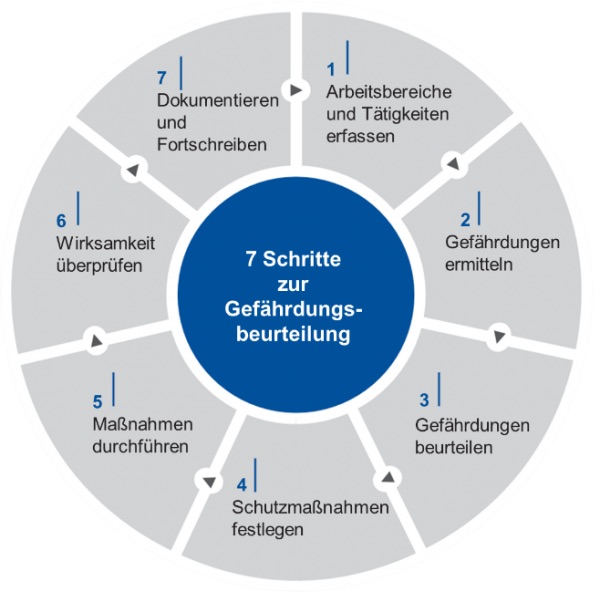
Occupational health and safety: a cornerstone of corporate success
The health of each individual employee is a company’s most valuable asset. That is why occupational health and safety should be a central and fundamental pillar of the corporate structure. A strong commitment in this area not only ensures the well-being of the workforce, but also contributes significantly to the long-term success and sustainability of the company.
We provide comprehensive support in implementing effective occupational health and safety measures in your company and would like to present our range of services to you. Our experts are at your side to work with you to create a safe and healthy working environment.
Effective accident analyses: More than just identifying human error.
When evaluating causes, events, incidents and near misses in accident analyses, often only the obvious causes are considered. Human error is frequently highlighted as the main cause, which means that many accident analyses fail to provide deeper insights into process or procedural deficiencies.
Holistic accident analyses, also known as root cause analyses, on the other hand, get to the bottom of the underlying causes of accidents. The aim is to eliminate problems at their ‘roots’ and find sustainable solutions to prevent them from recurring. This approach allows valuable lessons to be learned from accidents and preventive measures to be derived.
Methodical approach to accident analysis
A comprehensive accident analysis should be methodical and structured. Important steps in this process are:
- Information gathering:
Collect all relevant data on the accident. - Conduct interviews:
Interviews with affected and involved persons. - Documenting the accident description:
Precise description of the course of the accident. - Identifying causes:
Identifying the underlying causes. - Defining measures:
Defining measures for accident prevention.
Legal requirements and operational implementation
According to Section 6 of the Occupational Safety and Health Act (ArbSchG), employers are obliged to record accidents at work and take the necessary protective measures based on the risk assessment. We support you in creating and implementing company-specific accident statistics. The aim is to identify accident blackspots, develop effective protective measures and review their effectiveness.
Accident prevention in accordance with DGUV Regulation 2: Your advantages as an entrepreneur
The accident prevention regulation DGUV Regulation 2 represents a uniform specification of the Occupational Safety Act (ASiG) for professional associations and public accident insurance providers. As an entrepreneur, you benefit from the flexible options offered by this regulation, as you can decide for yourself which services are most appropriate for your business or company.
Occupational health and safety support in accordance with DGUV Regulation 2
Occupational health and safety support is divided into two main areas:
1. Basic care:
The operating hours for basic care are mainly based on the number of employees and the type of business. For each type of business, DGUV Regulation 2 specifies the required basic care operating hours per year based on the number of employees.
2. Company-specific support:
Company-specific support goes beyond general basic support and is tailored to the specific needs and risks of your company. While basic support provides a general foundation, company-specific support focuses on the specific challenges and requirements that may arise in your company.
- Flexibility:
The actual time required for company-specific support can only be determined during the support process. With the help of the checklists in DGUV Regulation 2 (e.g. target/actual comparison), we can accurately estimate the time required and respond flexibly to your needs. - Individual adaptation:
This support is provided as needed and in close coordination with HSE-Ingenieure GmbH and your company. We tailor our services precisely to the circumstances of your company – whether through special accident prevention measures, special training courses or individual safety concepts. - Continuous monitoring and adaptation:
Company-specific support is not static; it is regularly reviewed and, if necessary, adapted to changed operating conditions or new legal requirements. In this way, we ensure that your safety measures are always up to date and function optimally.
Occupational health services: Focus on health and prevention
Occupational health services are a key component of care in accordance with DGUV Regulation 2 and aim to promote employee health and prevent work-related illnesses. Here are some of the key areas of occupational health services:
- Occupational health care:
Occupational health care includes regular occupational health examinations to identify health risks at an early stage and take preventive measures. This is particularly important in industries where employees are exposed to specific hazards, such as noise, hazardous substances or physical strain. - Advice on ergonomics and workplace design:
Our occupational physicians provide comprehensive advice on the ergonomic design of workplaces to prevent musculoskeletal disorders and improve working conditions for your employees. - Workplace health promotion:
Occupational health services support you in implementing health promotion programmes, such as exercise and nutrition programmes, stress management or smoking cessation courses. The aim is to increase the general well-being of employees and reduce absences due to illness. - Accident prevention and emergency management:
Occupational physicians play an important role in preventing accidents at work and preparing for emergency situations. They assist in the development of emergency plans and train employees in first aid measures and emergency procedures. - Vaccinations and preventive measures:
Company doctors also offer vaccinations and preventive measures tailored to the specific requirements of your company, e.g. flu vaccinations or special vaccinations for employees who travel internationally.
Tailored support for all industries
We offer individualised, needs-based support from our experienced safety engineers/safety specialists and company doctors, regardless of industry – whether administration, production, trade or commerce. It doesn’t matter whether you are a small business owner, a medium-sized company or part of a larger corporate group. Our services are flexible and tailored to the specific needs of your business.
Our company-specific support and comprehensive occupational health services ensure that your company not only complies with legal requirements but is also optimally protected against accidents and health risks. Our goal is to work with you to create a safe and healthy working environment in which your employees are protected and your business processes are efficient.
Safety specialist: Your expert for occupational safety and health protection
According to the Occupational Safety Act (ASiG), a safety specialist (also known as an occupational safety specialist) is a company consultant who supports the employer in the areas of occupational safety, health protection, accident prevention and all issues relating to the humane design of work. It is important to emphasise that the safety specialist should not be confused with the safety officer or the ‘safety manager’.
According to Section 5 ASiG, the safety specialist must be appointed in writing by the employer, with the involvement of the works council or staff council. They report directly to the head of the company (Section 8 (2) ASiG) and work in a so-called ‘staff position’.
Tasks and working hours of the safety specialist
The areas of responsibility of safety engineers and occupational safety specialists are clearly defined in Section 6 ASiG. Their main tasks include:
- Advice and support for employers:
The safety officer provides advice on all matters relating to occupational safety, health protection and accident prevention. - Risk assessment:
Conducting and documenting risk assessments to identify and minimise risks in the workplace. - Post-incident analysis:
Investigating accidents and critical incidents to prevent future occurrences. - Relational prevention:
Developing and implementing measures that improve working conditions in the long term. - Behavioural prevention:
Training and measures to promote safe behaviour among employees.
The working hours of the safety specialist are specified per employee and year in DGUV Regulation 2 in order to ensure adequate supervision.
External safety specialist: your solution for operational safety
We offer you the opportunity to integrate an external safety specialist into your company. Our experienced specialists provide you with comprehensive support in:
- Designing a company-specific organisation:
We help you to effectively integrate health and safety measures into your management activities. - Work design and prevention:
Our work focuses on both situational prevention (e.g. ergonomic workplace design) and behavioural prevention (e.g. training courses on safe behaviour). - Conducting risk assessments:
Identify and minimise risks in the workplace with our support. - Incident analysis:
We analyse accidents and critical incidents in order to derive preventive measures and prevent future incidents.
In addition, we support management, executives and all employees with comprehensive, company-specific consulting services. Our external safety experts ensure that your company not only complies with legal requirements, but also provides a safe and healthy working environment for all employees.
In order to effectively prevent work-related illnesses and detect existing illnesses at an early stage, occupational health care is essential for providing employees with personal information and advice. The Occupational Safety and Health Act (ArbSchG) forms the legal basis for health protection in the workplace in Germany and aims to improve the safety and health of employees.
Occupational health care as part of health protection
A central component of occupational health prevention measures is occupational health care, which is regulated by the Occupational Health Care Regulation (ArbMedVV). This regulation defines the obligations and measures that companies must take to ensure the health protection of their employees.
Our extensive partner network offers you comprehensive support in the following areas:
Basic care in accordance with DGUV Regulation 2
- Participation in ASA meetings:
Support at regular meetings of the occupational safety committee. - Participation in ASiG inspections:
Accompaniment and advice during inspections in accordance with the Occupational Safety Act. - Support with risk assessment:
Expert advice and implementation of risk assessments. - Advice on health protection:
Comprehensive advice on all issues relating to occupational health protection. - Company-specific support:
Tailor-made solutions that meet the specific requirements of your company.
Occupational health care in accordance with ArbMedVV
- Mandatory, optional and voluntary preventive care:
Implementation of and advice on all forms of occupational health care in accordance with ArbMedVV. - G examinations:
Implementation of preventive medical check-ups based on the recommendations of the professional associations (e.g. G25/G41). - Aptitude examinations:
Specific examinations to determine suitability for certain activities (e.g. working at heights, driving and control activities). - Infection control and vaccinations:
Consulting on infection risks and implementation of occupational vaccinations, including yellow fever vaccinations. - Examinations in accordance with fire service regulations:
Special examinations for firefighters to ensure their operational readiness. - Youth Employment Protection Act and Working Hours Act:
Examinations to ensure compliance with legal requirements, e.g. suitability for shift work. - Travel medicine and G35 preventive care:
Advice and vaccinations for employees who travel internationally or work in high-risk areas. - Occupational health management (BGM) and occupational health promotion (BGF):
Support in planning and implementing health days, training courses and check-ups to promote employee health.
Types of occupational health care
Occupational health care can be divided into three categories:
- Mandatory preventive care:
This preventive care is mandatory and must be carried out before employees commence hazardous activities. It serves as a prerequisite for employment and protects employees from specific health risks. - Optional preventive care:
The employer must offer this preventive care for certain hazardous activities. Participation is voluntary for employees, but strongly recommended in order to identify potential health risks at an early stage. - Optional preventive care:
At the employee’s request, the employer must provide this preventive care unless the risk assessment shows no relevant health risks. This preventive care option offers employees additional security and clarity about their health status.
Comprehensive occupational health care not only contributes to the health and safety of your employees, but also ensures that you meet all legal requirements necessary for the protection of your workforce. Our network of experienced occupational physicians and health consultants supports you in implementing these tasks efficiently and effectively.
Employers are obliged under Section 167(2) of SGB IX (formerly Section 84(2) of SGB IX) to offer and implement a workplace integration management programme (BEM) for employees who have been unable to work for more than six weeks continuously or repeatedly within the last 12 months. The aim of BEM is to prevent further incapacity for work and to secure the job of the affected employee in the long term.
External partners in the BEM process
For people with a severe disability or an equivalent disability, the integration office or integration service should be involved in the BEM process. These external partners can provide valuable support in designing a workplace that is suitable for people with disabilities.
Our service: Support in the BEM process
We offer comprehensive support in all phases of workplace integration management:
- Reintegration measures (Hamburg model):
We support you in the gradual reintegration of your employees into everyday working life, tailored to their individual needs. - Designing replacement workplaces to suit specific conditions:
We help to adapt existing workplaces or create new ones that are suitable for employees with health restrictions. - Matching job requirements and performance profiles:
We support you in optimally matching job requirements to the performance capabilities of your employees. - Support with BEM discussions:
Our experts are at your side to help you plan and conduct BEM discussions in order to find constructive solutions for all parties involved.
With our support, you not only ensure the health and ability to work of your employees, but also comply with the legal requirements of SGB IX. Rely on our expertise to make the BEM process successful and efficient.
Mental stress in the workplace: causes, challenges and solutions
Mental stress in the workplace can have many causes. Basically, mental stress factors can be identified that are related to problems with work tasks, work organisation, social relationships or the working environment itself. These stress factors can have serious psychological consequences for those affected.
Legislators have recognised this problem and mental stress has been defined as a serious issue in the Occupational Safety and Health Act for some time now. Every employer is obliged to identify far-reaching hazards caused by mental stress and to take appropriate measures to avoid them.
Challenge for employers: risk assessment of psychological stress
Although the Occupational Safety and Health Act provides clear guidelines for identifying hazards, the legislator does not provide any specific guidelines on how to carry out a risk assessment of psychological stress. This poses a major challenge for many companies.
What we offer: Individual support with psychological risk assessment
To help you meet these legal requirements, we offer a tailored and methodical approach to assessing and reducing psychological stress in the workplace:
- Measuring and evaluating defined psychological stress factors:
We identify and measure the specific factors that can lead to psychological stress. - Analysing and explaining causal relationships:
We explain the relationships between problematic work situations and the associated psychological stress. - Assessment of the working environment:
We carry out a comprehensive assessment of the working environment to identify potential sources of stress. - Evaluation and assessment:
The data collected is thoroughly evaluated and assessed in order to make informed decisions. - Definition and implementation of measures:
We develop concrete measures to reduce psychological stress and support you in their implementation. - Support with psychological risk assessment:
We guide you through the entire risk assessment process and ensure that all legal requirements are met. - Effectiveness monitoring and documentation:
After the measures have been implemented, we check their effectiveness and document the entire process to ensure compliance with legal requirements.
With our expertise, we help you systematically identify and assess psychological stress factors in your company and take effective measures to improve the working environment.
Risk assessments: An indispensable part of occupational safety
We all carry out risk assessments all the time, often without even realising it. Recognising and assessing risks is a natural part of our daily lives, much like eating and drinking. In our private lives, we rely on our personal experience to identify and avoid risks. In the workplace, however, hazards are not always obvious, which is why legislators have established clear requirements for systematic risk assessment.
Risk assessment: A duty and the basis for occupational health and safety
Legislators require employers to systematically identify all work-related hazards by means of a risk assessment. Suitable protective measures must then be defined and employees must be given adequate training. This procedure is not only required by law, but also forms the basis for occupational health and safety. A carefully conducted risk assessment is the basis for the humane design of workplaces.
Objective of risk assessment: protection of employees and third parties
The main objective of risk assessment is to identify accident and health hazards for employees and uninvolved third parties at an early stage and to take appropriate protective measures. Wherever possible, hazards should be avoided. If this is not possible, the aim is to reduce the risks to an acceptable and controllable level.
Input:
- Measurements
- Operating instructions
- Safety data sheets
- Regulations and rules
Output:
- Operating instructions
- Personal protective equipment (PPE)
- Instructions
- Occupational health precautions
- Labelling
Our support: Tailored risk assessments
We, the HSE engineers, support you in creating a company-specific risk assessment. Together, we develop a practical standard that gives you a clear overview of the main hazards in your company and suggests suitable measures for minimising risk. Our systematic approach to the analysis, evaluation and development of proposed measures provides you with a sound basis for your risk assessment.
Trust in our expertise to meet legal requirements while ensuring the safety and health of your employees.

Fig. Risk assessment
Operating instructions: guidance and safety for employees and third parties
Operating instructions are a key document that summarises the risk assessment and serves as clear guidance for employees and third parties on site. They ensure that all affected persons are informed at all times about the correct procedures for handling work equipment or hazardous substances.
According to Section 14 (1) of the Hazardous Substances Ordinance (GefStoffV), the employer is obliged to ensure that employees have written operating instructions. These must comply with the risk assessment according to Section 6 GefStoffV and be made available in a form and language that is understandable to employees.
Our services: Creation and updating of operating instructions
We support you in creating new operating instructions and updating your existing ones. Our goal is to ensure that your operating instructions always comply with the latest legal requirements and provide clear, understandable guidance for your employees.
Regular occupational safety training: Your obligations as an employer
According to Section 12 (1) of the Occupational Safety and Health Act (ArbSchG), employers are obliged to provide their employees with regular, sufficient and appropriate training on safety and health protection at work. This training must take place during working hours without any reduction in pay for the employee.
Initial training: The foundation for safe occupational safety
Initial training forms the basis for all further training in the company. It teaches the basic rules of occupational safety and must be provided when new employees are hired, when there are changes in the scope of duties, and when new work equipment or technologies are introduced. In addition, regular repetition of the training is required, as specified in Section 12 ArbSchG.
Repeat training: Deadlines and legal requirements
Although the Occupational Safety and Health Act does not prescribe fixed deadlines for repeat training, the intervals are based on operational requirements and the risk assessment. However, some special provisions of occupational safety and health and accident prevention regulations (UVV) stipulate specific intervals:
- Half-yearly training:
In accordance with Section 20 of the Compressed Air Ordinance (DruckluftV), Section 38 of the Radiation Protection Ordinance (StrahlSchV) and Section 28 of the Youth Employment Protection Act (JArbSchG). - Annual training:
According to Section 4 DGUV Regulation 1 (Principles of Prevention, formerly BGV A1) and Section 14 (2) Hazardous Substances Ordinance, initial training must be provided before starting work, followed by annual training.
However, some special provisions of occupational health and safety and accident prevention regulations (UVV) stipulate half-yearly (cf. § 20 DruckluftV, § 38 StrahlSchV, § 28 JArbSchG) or annual training. According to Section 4 DGUV Regulation 1 (Principles of Prevention – previously: BGV A1) and Section 14 (2) of the Hazardous Substances Ordinance, for example, initial training must be provided before the start of work, followed by annual training (training in accordance with DGUV Regulation 1).
We offer you the following support in the areas of occupational safety, fire protection, environmental protection and energy, depending on your needs:
- Preparation of training documents
- Review and compilation of all necessary training courses
- Creation of a training matrix
- Implementation of employee training
Behaviour-based safety (BBS): Prevention through safe behaviour
The majority of accidents in the workplace can be attributed to incorrect behaviour rather than technical shortcomings. To effectively prevent accidents, it is therefore crucial to create a strong safety awareness among all employees.
Although the initial time investment in raising awareness may seem high, this approach pays off in the long term. Once established, the process becomes a self-sustaining system that brings significant added value to the company.
Behaviour-based Safety (BBS): A proven approach to behavioural change
The Behaviour-based Safety (BBS) method has proven to be extremely effective in bringing about behavioural change in the area of occupational safety. BBS is not just a concept, but an ongoing process that creates a safety partnership between management and employees across all levels of the company.
Advantages of the BBS method
- Focus on daily safety behaviour:
BBS continuously directs employees’ attention and actions towards their own safety behaviour and that of their colleagues. - Commitment at all levels:
Close cooperation between management and staff develops a common understanding of safe working practices. - Long-term prevention:
The method promotes a cultural shift towards greater safety, which contributes to a long-term reduction in accidents and risks.
By implementing the Behaviour-based Safety (BBS) method, companies can not only increase safety levels, but also improve employee retention and motivation. Focusing on safe behaviour leads to a proactive approach to hazards and promotes a culture in which safety comes first.
Regular safety inspections: A must for effective occupational safety
According to the Occupational Safety Act (ASiG), employers are obliged to regularly inspect workplaces (Section 3 (1), (2) ArbSchG; Section 2 (2) ASiG). These safety inspections are an essential part of employers’ duties to continuously improve occupational safety.
Why are regular safety inspections important?
Regular safety inspections are essential to ensure that occupational safety measures in your company are actually effective. These inspections help you to identify deficiencies, problems and sources of danger at an early stage and to remedy them in a targeted manner.
Our services for safety inspections
- Identification of defects and sources of danger:
During regular inspections, we identify and assess potential risks in your company. This allows necessary protective measures to be taken in good time. - Follow-up inspections and documentation:
To ensure that identified defects are completely remedied, we carry out regular follow-up inspections. The documentation is continuously updated. - Target/actual comparison:
An essential part of our inspections is the comparison of the target and actual status in order to verify the effectiveness of the measures implemented.
Regular safety inspections not only help you comply with legal requirements, but also create a safe working environment for your employees. We support you in continuously improving occupational safety in your company.
Practical in-house training courses for your safety officers
We, the HSE engineers, offer tailor-made training courses for your safety officers, which are specifically tailored to the requirements of your company. Particularly noteworthy are our in-house seminars, which take place directly at your premises.
Advantages of our in-house training courses
- Focus on operational requirements:
Our training courses are practical and take into account the specific challenges and needs of your company. This ensures that the content taught can be directly applied to your operational reality. - Implementation expertise:
The key advantage of our in-house training courses lies in the ability to put theoretical content directly into practice. Your safety officers not only gain theoretical knowledge, but also practical guidance that they can apply directly in their everyday work.
With our practical training courses, we support your safety officers in expanding their skills and sustainably improving occupational safety in your company. Trust in our expertise to provide your employees with the best possible training.
Thorough inventory: The key to effective occupational safety, fire protection and environmental protection
An inventory is one of the most important methods for gaining a comprehensive picture of a company on site. It is essential that this is carried out thoroughly and in a structured manner. In addition to technical expertise, it is advisable to consult an internal contact person who is familiar with daily routines and technical equipment and can provide detailed information if necessary.
Our services: Detailed recording for safety and protection
We offer you a comprehensive inventory of your company, buildings and technical equipment, with a particular focus on occupational safety, fire protection and environmental protection. Our recording includes the following points:
- Thorough documentation:
All relevant data is carefully recorded and documented in writing. - Visual support:
The results of the inventory are supplemented with images to ensure a clear and vivid representation of the situation. - Deficiency- and solution-oriented consulting:
In addition to identifying deficiencies, the focus is on developing practical solutions to optimise safety and security in your company.
Our detailed inventory provides you with a sound basis on which to take targeted measures to improve safety, fire protection and environmental protection in your company.
Cost savings through tailored HSE support
To achieve cost savings in your company, well-organised support tailored to the specific needs of your company is essential.
Needs analyses: Optimisation of occupational health and safety, fire protection and environmental protection
Our needs analyses enable you to determine exactly how well your company is currently positioned in the areas of occupational health and safety, fire protection and environmental protection (HSE: Health, Safety, Environment). This analysis provides you with valuable insights into the status quo of your HSE measures.
Tailor-made concepts for sustainable improvements
Based on the results of our needs analysis, we develop an individual concept that is precisely tailored to the requirements of your company. This concept picks up exactly where your previous measures end and offers targeted solutions for optimising your HSE strategies.
Root cause analysis for planning errors and deviations
Our detailed analysis also shows you the causes of possible planning errors and deviations throughout your entire operation. This allows you to identify weaknesses at an early stage and take targeted measures for improvement.
With our support, you can not only improve safety and protection in your company, but also realise significant cost savings.
Occupational safety: A must for small businesses too
Occupational safety is crucial not only in large companies, but also in small businesses. The aim is to prevent accidents before they happen and to encourage employees to act responsibly in the workplace. In addition to internalising general work processes, employees must know exactly which protective measures are required at their respective workplaces. In the hustle and bustle of everyday working life, this can be challenging, which is why the employer’s role model function is particularly important: they must follow the required instructions themselves and take consistent action in the event of violations by employees.
Occupational safety as a team task in small businesses
In small businesses, it makes sense to discuss the topic of occupational safety with the entire team. The advantage is obvious: every employee is aware of the potential hazards and knows the preventive measures required at the various workplaces. Such discussions often give rise to new ideas that can further improve occupational safety.
Legal obligations also apply to small businesses
Anyone who employs staff is legally obliged to take certain organisational measures to ensure occupational safety – this also applies to marginal part-time employees, temporary staff and agency workers. Even companies where ‘nothing has ever happened’ must implement these measures. Today, occupational safety encompasses much more than just accident prevention – health protection also plays a central role.
DGUV Regulation 2: Working hours in small businesses
For businesses with up to ten employees, DGUV Regulation 2 does not specify any fixed minimum working hours. Instead, the company doctor and occupational safety specialist agree on the necessary working hours with the employer on the basis of the risk assessment. The company doctor and safety specialist are also available for ad hoc support, which the employer can request on special occasions. Such occasions can already be identified as part of the risk assessment.
Safety standards and external contractor management: Minimising risks when working with external contractors
From an economic perspective, the use of external companies offers numerous advantages, particularly in terms of flexibility and cost efficiency. However, this flexibility also entails risks for the client. External companies often work under considerable time pressure, have little local knowledge and must quickly adapt to a new, unfamiliar working environment – often in hazardous work areas. This increases the risk of accidents and can lead to safety issues.
Necessity of safety standards and regulations
In order to minimise these risks, it is essential to establish and coordinate safety standards and regulations and to set them out in appropriate contracts. This can help to avoid both legal and economic challenges.
As the client, you should ensure that only suitable, sufficiently qualified and trained personnel are employed in the operational business and that all legal regulations are strictly adhered to.
Our support in working with external companies
We offer you comprehensive support in implementing specific occupational health and safety regulations in the contractual services. This includes:
- Employee registration:
Support in regulating access to the company premises for external company employees. - Identification of specific sources of danger:
Advice on specific risks and measures to minimise these dangers. - Employee training:
Conducting training on health and safety, both during normal operations and in the event of an emergency. - Definition of operational responsibilities:
Support in defining responsibilities and authority within the company.
Additional services to safeguard the work of external companies
We also offer the following services to ensure security and efficiency when working with external companies:
- Creation of external company regulations:
Development of a comprehensive set of rules for the use of external companies in your business. - Introduction of external company management:
Establishment of a structured management system for coordinating and monitoring the use of external companies. - Support in instructing the person responsible for the assignment:
Training of the responsible persons in your company to ensure smooth cooperation. - Briefing of external company managers:
Support in briefing the responsible persons of the external companies on the specific safety requirements of your company. - Coordination and monitoring of activities:
Ongoing support in coordinating and monitoring the activities of external companies to ensure that all safety regulations are complied with.
With our expertise, we ensure that cooperation with external companies in your company is secure, efficient and legally compliant.
Employer obligations in occupational safety: delegation and legal responsibility
The fundamental responsibility for occupational safety and health protection in the workplace lies with the employer. In larger companies, however, it is often necessary to delegate this responsibility to operational supervisors – a process known as the transfer of duties. However, the associated rights and, above all, obligations are not always clear to everyone involved.
Our services: Training and legal support
We provide you with the legal background to the transfer of employer obligations and support you with targeted training for managers. In doing so, we address the most important questions to ensure that the delegation of duties is legally effective and clearly understood within the company.
Topics we clarify for you:
- Why are entrepreneurial responsibilities transferred?
We explain the necessity and advantages of transferring responsibilities, especially in larger companies. - What responsibilities does the entrepreneur have?
We clarify which responsibilities remain with the entrepreneur and how these differ from the responsibilities of the agent. - Differences between entrepreneur and agent:
We show what distinguishes the responsibilities of an entrepreneur from those of an agent. - Planner vs. operator:
We explain the differences between the roles of a planner and an operator, and where the respective responsibilities lie. - Responsibility of operators and owners:
We highlight the specific duties of operators and owners and the resulting responsibilities. - Special operator duties:
We explain exactly what is meant by special operator duties and how these are implemented in practice. - Importance of risk assessment:
We emphasise the central role of risk assessment in occupational safety and its importance for legal protection. - Possible consequences:
We provide information about the legal and business consequences that can result from a breach of duties.
With our support, you can ensure that the transfer of responsibilities in your company is carried out in a legally compliant manner and that all parties involved are fully informed about their responsibilities and tasks in the area of occupational health and safety.
SCC Management: Safety, Health and Environmental Protection in Industry
In order to ensure comprehensive occupational health and safety in industry, particularly in the petrochemical industry, many companies require their partners and external contractors to provide evidence of their knowledge in the areas of safety, health and environmental protection (SHE).
SCC management (Safety Certificate Contractors) offers an internationally recognised safety standard for all companies operating as external contractors or subcontractors. SCC is the key to ensuring a uniform and high level of safety worldwide.
Our goal: imparting and deepening SGU knowledge
To enable your company or business to actively shape its safety, health and environmental policy, we are committed to imparting and deepening the necessary knowledge about safety-conscious behaviour to your managers and employees. We initially focus on the fundamental aspects of the SCC safety standard.
Further training in SCC safety management
Beyond the basics, we impart in-depth knowledge of safety management in accordance with the SCC certification system. This includes:
- Basic safety standards:
Training courses covering the core principles of the SCC standard. - Implementation in the workplace:
Practical application and implementation of SCC guidelines in your company. - In-depth HSE knowledge:
Advanced training courses on specific topics relating to safety, health and environmental protection in accordance with SCC.
With our support, you can ensure that your company complies with the international SCC standard, thereby guaranteeing the highest level of safety, health and environmental protection in your operations.
Occupational safety in care facilities
Occupational safety in care and nursing homes is crucial to ensuring both the health of employees and the well-being of residents. It encompasses various measures and guidelines aimed at minimising risks and hazards. These include:
Training and continuing education: Regular training for nursing staff on safety regulations, emergency management and dealing with difficult situations.
Ergonomics: The introduction of ergonomic working methods to prevent injuries, especially during lifting activities and prolonged standing.
Hygiene and infection control: Strict hygiene protocols to prevent the spread of disease, especially during epidemics.
Safety equipment: Provision of personal protective equipment (PPE) such as gloves and masks, as well as safe access to aids such as wheelchairs and mobilisation technology.
Mental health: Measures to support the mental health of employees in order to minimise stress and burnout.
Emergency management: Plans and training for dealing with emergencies in order to be able to respond quickly and effectively.
Implementing these measures not only increases occupational safety, but also improves the quality of care for residents.






